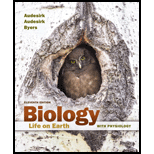
Concept explainers
To interpret:
The finding with respect to the ecological niche and the competitive exclusion principle, and also explain both concepts.
Introduction:
When two species or individual compete with each other for same
All the species thrive for survival, growth, and reproduction requires niche. Every species require a set of resources specifically along with habitats for their survival in an environment, it is called as the ecological niche.
Explanation of Solution
According to the competition and exclusion principle, different species that live in the same ecological niche can not depend on the same resources. They depend upon other resources and therefore, reduce the competition for resources that allows for the co-existence of different species.
If two species of birds that are closely related and vary with in their size of bills, it is an evident that they cannot compete with each other for the same resource. Such as both species of birds are susceptible that they do not “compete for feeding”. They are able to co-exist when; they are depending on other resources present in the same ecological niche. Therefore, it is appropriately an example of the “competition exclusion principle to share an ecological niche”.
Thus, two species overlap their niche for their survival. The competition exclusion principle describes that two species or individuals cannot live in the same niche and also depend on the same resources for an indefinite period of time.
Want to see more full solutions like this?
Chapter 28 Solutions
Biology: Life on Earth with Physiology Plus Mastering Biology with Pearson eText -- Access Card Package (11th Edition)
- According to the resource-ratio hypothesis (a.k.a. R-star), what factor(s) will determine the maximum number of competing species that could possibly coexist in a community? (Note: either one or more-than-one answer could be correct) .what does the number of limiting resources in a community tell us? The number of limiting resources in the community The net primary productivity of the community (NPP). The number of trophic levels that are present in the community. | The intrinsic rate of increase (r) of each species in the community. The colonization rate of each species that can access the habitat.arrow_forwardWhat is the principle that teaches us that two species cannot coexist in the exact same niche in the same habitat.This is because species with same niches have comparable requirements, which implies they would fight for the same resources.arrow_forwardDiscuss competition between species, the competitive exclusion principle, and the phenomenon of niche or resource partitioning. How do they compare and/or contrast?arrow_forward
- Species facing competition might evolve mechanism that promotes coexistence rather than exclusion. Justify this statement in light of Gause’s competitive exclusionprinciple, citing suitable examples.arrow_forwardA niche is loosely defined as an organism's role in its environment, which can include factors such as feeding preference, nesting behaviors, mating behaviors, method of obtaining prey, and local habitats. Keeping Gause's law in mind, do some research on the California red-legged frog and the North Pacific tree frog (use wiki or another Google search). Create a chart comparing the two with respect to their niche or lifestyle that can explain how these two frogs can co-exist in the same ecosystem.arrow_forwardA conceptual model representing the role, interaction, reaction, and density of essential ecosystem components is shown below. Examine the model and the relationships between the major players (i.e., predator, prey, producer). The structure's most important role is played by these major players. It's also worth noting that nutrition has been included in the model. This is the abiotic component that has a direct or indirect impact on the interaction. Question: Based on this scenario, what is the most significant role of sea otters in the marine community? Why it’s important?arrow_forward
- If you had to monitor an ecosystem for evidence of pollution, what are one or two indicator species you would want to pay particularly close attention to? You may discuss specific species of organisms, or can discuss organisms that occupy a specific trophic level in an ecosystem’s food web. Explain why you would select these species or this trophic level.arrow_forwardThe moray eel and cleaner wrasse story at the beginning of the chapter is an example of which type of community interaction? O Competition O Mutualism O Parasitism O Predationarrow_forwardExplain what occurs during competitive exclusion and resource partitioning.arrow_forward
- A conceptual model representing the role, interaction, reaction, and density of essential ecosystem components is shown below. Examine the model and the relationships between the major players (i.e., predator, prey, producer). The structure's most important role is played by these major players. It's also worth noting that nutrition has been included in the model. This is the abiotic component that has a direct or indirect impact on the interaction. Question: Why does the organism’s interaction appear in an oscillating pattern? What does it suggest?arrow_forwardAlthough a species might be physiologically able to live under a wide range of resource conditions, competitors may restrict its use of resources in a particular location. This is known as a character displacement. b mutualism. c realized niche. d fundamental niche. e interference competition.arrow_forwardCompetitive exclusion occurs under the following conditions: a. when fundamental niches overlap and competition is asymmetric b. when realized niches overlap and competition is asymmetric c. when fundamental niches overlap and competition is symmetric d. when realized niches overlap and competition is symmetric e. when competition is excluded because niches do not overlaparrow_forward
 Biology: The Dynamic Science (MindTap Course List)BiologyISBN:9781305389892Author:Peter J. Russell, Paul E. Hertz, Beverly McMillanPublisher:Cengage Learning
Biology: The Dynamic Science (MindTap Course List)BiologyISBN:9781305389892Author:Peter J. Russell, Paul E. Hertz, Beverly McMillanPublisher:Cengage Learning
